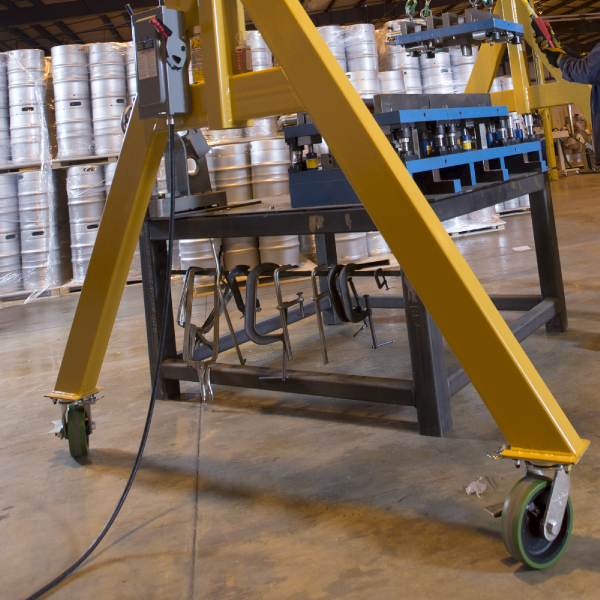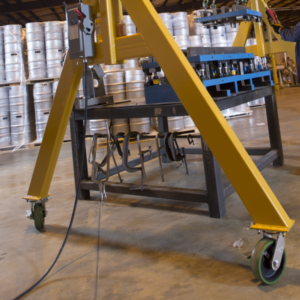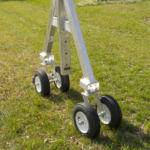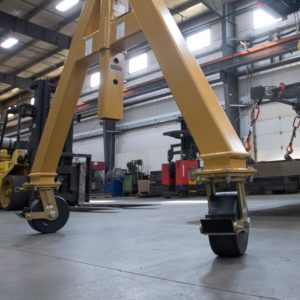
Choosing the Right Casters: How Much Force Is Required to Move the System?
Dic 9, 2024
For effortless movement of your gantry system, using the correct casters is key. At Spanco, we commonly quote three types of swivel casters: polyurethane, nylacron, and pneumatic. Each type of caster comes with its own pros and cons. How do you know which one is best for your system?
The materials that each caster is manufactured to function differently depending on the environment. The overall goal when using a Spanco Gantry crane, as well as any overhead crane system, is to increase your workplace productivity in a sufficient manner. That is why using the proper casters for your specific application is important. Using the wrong type may result in greater force needed for movement, injury from straining, or loss of loads due to instability.
When choosing the correct casters, take these important factors into consideration:
- loads
- tread material/hardness
- floor conditions
- floor finishes
Ergonomics
Choosing the proper casters affects the ergonomics of your work facility. Pushing a gantry system rather than pulling is safer and more efficient. Pulling can increase the chances of injury due to the stretched and unsupported position of a worker’s arm and back. The backward motion and the amount of force being exerted when pulling materials and machinery can result in getting run over by equipment. These dangers are amplified because pulling the system means you can’t see where you’re walking. Having the correct casters for your application will prevent unnecessary hardship by allowing for less force to be used.
Polyurethane Casters

Polyurethane casters are the low-maintenance option for your system. Constructed with little tread, this type of caster is most beneficial in an indoor application. Compared to pneumatics’ rubber tread, polyurethane has a low rolling resistance, which allows the material to glide over smooth concrete surfaces with relative ease. The amount of force to initiate movement for a Spanco Gantry that uses polyurethane casters is approximately five percent of the system’s rated capacity, approximately two percent to continue moving, and approximately seven to 15 percent of the system’s rated capacity to turn.
While the solidity of the casters makes for easy motion, if used on uneven terrain, the small wheel diameter and hardness of the tread would make your gantry system difficult to push over surface irregularities. However, the rated capacity for polyurethane can far exceed what a rubber tire can handle. Overall, polyurethane casters require little relative force for motion and have strong weight capacities, but can only be used on smooth, level surfaces.
Pneumatic Casters

Pneumatic tires are pressurized rubber tires with a flexible tread for shock absorption. These tires are the same type that would be used on your car, motorcycle, ATV, or other vehicles. Pneumatic tires fare better on pavement compared to polyurethane casters because the tread allows for a cushioned roll.
Pneumatic tires can either be foam-filled or air-filled. There are benefits to both options, but the choice will boil down to what is right for your application. Foam-filled tires are a sturdier alternative to air-filled tires that can deflate. When employing air-filled tires, you must monitor air pressure and be wary of punctures. While foam-filled tires are more durable, they are heavier and require more strength to push your system. Due to the solidity of the tire, foam-filled tires do not have the cushioned and smooth ride that air-filled tires provide.
A downfall when using both kinds of pneumatic tires is that they require more force to start motion. Due to the flexibility of the air-filled and foam-filled tire, it requires approximately 15-20 percent of the system’s rated capacity to initiate and continue movement. It is also harder for the wheel to pivot, meaning more force is needed to turn your system. Additionally, the rated capacity is incumbent on the size of the wheel. Therefore, purchasing larger pneumatic tires for greater capacities is necessary, while nylacron or polyurethane casters can handle larger capacities.
When should you use a polyurethane, nylacron, or pneumatic caster? The answer lies in the use you need to get out of your Spanco Gantry system. The force needed for these casters can sometimes be compared to pushing a skateboard and pushing a cart. The purpose of your system ultimately will enable you to determine which caster is necessary to achieve the motion you desire.
Nylacron™ Casters

Nylacron casters are best used for heavy-duty applications as an ergonomic alternative to motorization. Manufactured from compressed cast polyamide, this material can handle heavy capacities at the lowest rolling resistance. The rolling resistance for these casters allow for easier movement in indoor applications than polyurethane casters. Nylacron casters are easy to maneuver compared to polyurethane casters and pneumatic tires. To generate initial movement, the force required is approximately less than one percent of the system’s rated capacity, approximately less than one-half percent to continue movement, and approximately three to five percent of the system’s rated capacity to turn. The strength of this material enables a high-rated capacity with the smallest amount of effort to move the system.
Benefits of Nylacron™ Casters
Although any Spanco gantry can use them, Nylacron casters are typically used as a cost-effective alternative to motorization. While there are certainly benefits to polyurethane and pneumatic casters as well, the Nylacron caster offers its own unique advantages, especially if you’re a business that’s operating on a modest budget. This article discusses some of those unique features.
Easy to Push
Nylacron’s biggest advantage is its capacity to carry heavy loads while remaining exceptionally easy to move. How easy? To get Nylacron wheels moving, you need a force less than one percent of the system’s rated capacity. Keeping those wheels turning takes even less: a force equal to less than one-half percent. That means far less force is required to push or pull the system, so one or two workers can easily move the system instead of having to rely on multiple nearby workers to help.
Quiet and Resilient
The Nylacron material is a highly compressed cast polyamide. When polyamides are not shaped into wheels for rolling industrial equipment, they can be found in wool, carpets, textiles, nylons, and other soft materials. This relative elasticity gives Nylacron products shock-dampening and vibration-reduction properties, both of which significantly reduce the noise associated with pushing heavy loads. It also gives the wheel much higher resilience to return to its original shape without deformation when bent by heavy or rapidly applied loads.
Strong as Steel
Surprised that wheels made out of material used in jerseys and carpets can support industrial loads? Don’t be. Acorn’s casting process turns their raw materials into polyamides that boast strength equivalent to steel at one-third the weight.
Low Maintenance
Finally, Nylacron’s sealed precision bearings and relatively small design minimize the daily wear and tear experienced by other types of wheels. Nylacron is durable. Even after extended use, it resists damage from water and many hazardous chemicals, and it remains functional in temperatures from -30° to 220° F. The bottom line is that you will have far less maintenance to perform on Nylacron casters. As an added bonus, you’ll have less maintenance to perform on the floors of your facility too because Nylacron will not damage most flooring types.
There you have it: the four biggest reasons Spanco uses Nylacron casters as part of our product offerings. If you believe your operation would benefit from a Spanco product using Nylacron casters, contact us or locate one of our reps in your area and let them know you’re interested.
Categories
Share this post
Contact us
Looking for the perfect fall protection equipment? Let us help!